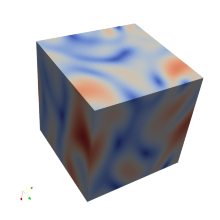Diffusion is one of the essential processes that determines the composition and thus the dynamics of a combustion process at the molecular level. It is a mixing process that compensates for concentration gradients of the different substances at different rates, which can lead to a decorrelation of individual substance sizes and thus to altered flame structures and dynamics. In most cases, it is assumed that turbulent mixing is dominant and differential diffusion is consequently neglected. However, experiments and simulations have shown that differential diffusion can influence flame structure, stabilization and ignition behavior, oxidation processes in synthesis gases and flame speeds. For example, temperatures can locally be far more than 100K above corresponding values of the chemical equilibrium, primarily due to the increased diffusion of hydrogen. New modelling strategies for differential diffusion are therefore necessary and highly topical, especially with the growing interest in carbon-reduced or even carbon-free combustion.
In this project, we model differential diffusion in turbulent flows with the use of the stochastic implementation of the multiple mapping conditioning (MMC) framework, coupled to a large eddy simulation (LES) solver. Here, MMC is a probability density function (PDF) method for turbulence-chemistry interaction modelling, in which the PDF is represented by a number of stochastic particles. It provides an improved model for turbulent and molecular mixing that ensures locality in both physical space and reference variable space. In this project, a sparse Lagrangian formulation of MMC-LES is used, where the number of stochastic particles is lower than the number of Eulerian grid cells. The differential diffusion models shall be developed with the aid of statistically zero- and one-dimensional direct numerical simulations (DNS) of non-reacting and reacting flows. As a final step, the models shall be validated using experimental data of turbulent diffusion flames where differential diffusion effects were measured.
Movie 1
Movie 1: The animation shows the direct numerical simulation of differentially diffusing passive scalars mixing in decaying homogeneous isotropic turbulence. The left box shows the mass fraction of Species1, which was initialized to homogeneous blobs and mixed with a second scalar in the turbulence. The mass fraction of the diluent species in the right box serves as an indicator for differential diffusion wherever the mass fraction deviates from 0.9.
Related publications
- A. Kronenburg and R. W. Bilger, “Modelling of differential diffusion effects in nonpremixed nonreacting turbulent flow,” Physics of Fluids, vol. 9, no. 5, pp. 1435–1447, (1997).
Contact

Andreas Kronenburg
Univ.-Prof. Dr.Director of the Institute

Thorsten Zirwes
Dr.-Ing.Deputy director

Sergio Gutiérrez Sánchez
Scientific staff


